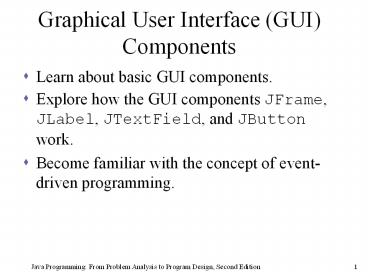Learn about basic GUI components. - PowerPoint PPT Presentation
1 / 29
Title:
Learn about basic GUI components.
Description:
Graphical User Interface (GUI) Components Learn about basic GUI components. Explore how the GUI components JFrame, JLabel, JTextField, and JButton work. – PowerPoint PPT presentation
Number of Views:125
Avg rating:3.0/5.0
Title: Learn about basic GUI components.
1
Graphical User Interface (GUI) Components
- Learn about basic GUI components.
- Explore how the GUI components JFrame, JLabel,
JTextField, and JButton work. - Become familiar with the concept of event-driven
programming.
2
Graphical User Interface (GUI) Components
- Discover events and event handlers.
- Explore object-oriented design.
- Learn how to identify objects, classes, and
members of a class.
3
Graphical User Interface (GUI) Components
- View inputs and outputs simultaneously.
- One graphical window.
- Input values in any order.
- Change input values in window.
- Click buttons to get output.
4
Java GUI Components
5
Graphical User Interface (GUI) Components
- GUI components placed in content pane.
- GUI components
- Windows
- Labels
- Text areas
- Buttons
6
GUI Components
- Added to content pane of window.
- Not added to window itself.
- Pixel A picture element.
7
Windows
- Can be created using a Frame object.
- The class Frame provides various methods to
control attributes of a window. - Measured in pixels of height and width.
- Attributes associated with windows
- Title
- Width
- Height
8
class JFrame
- GUI window instance created as instance of Frame.
- Provides various methods to control window
attributes.
9
Methods Provided by the class JFrame
10
Methods Provided by the class JFrame
11
Two Ways to Create a Window
- First way
- Declare object of type JFrame.
- Instantiate object.
- Use various methods to manipulate window.
- Second way
- Create class-containing application program by
extending definition of class JFrame. - Utilize mechanism of inheritance.
12
Content Pane
- Inner area of GUI window (below title bar, inside
border). - To access content pane
- Declare reference variable of type Container.
- Use method getContentPane of class JFrame.
13
Methods Provided by the class Container
14
class JLabel
- Labels Objects of a particular class type.
- class JLabel Used to create labels.
- Label attributes
- Title
- Width
- Height
- To create a label
- Instantiate object of type JLabel.
- Modify attributes to control display of labels.
15
Methods Provided by the class JLabel
16
Methods Provided by the class JLabel
17
class JTextField
- Text fields Objects belonging to class
JTextField. - To create a text field
- Declare reference variable of type JTextField.
- Instantiate object.
18
Methods Provided by the class JTextField
19
class JButton
- Provided to create buttons in Java.
- To create a button
- Use the same technique that is used to create
JLabel and JTextField.
20
Methods Provided by the class JButton
21
Methods Provided by the class JButton
22
Handling an Event
- Action event An event created when JButton is
clicked. - Event listener An object that receives a message
when JButton is clicked. - In Java, you must register the listener.
23
Handling an Event
- class ActionListener
- Handles action event.
- Part of package java.awt.Event.
- The class ActionListener is a special type of
class (interface). - Must contain the actionPerformed method.
24
Rectangle Program Sample Run
25
Programming Example Temperature Conversion
- Input Temperature in Fahrenheit or Celsius.
- Output Temperature in Celsius if input is
Fahrenheit temperature in Fahrenheit if input is
Celsius.
26
Programming Example Temperature Conversion
- Solution
- Create the appropriate JLabels, JTextFields,
JButtons. - Add them to the created content pane.
- Calculate the appropriate conversions when the
buttons are clicked and an event is triggered.
27
Sample Run for TempConversion
28
Object-Oriented Design
- Simplified methodology
- Write down detailed description of problem.
- Identify all (relevant) nouns and verbs.
- From list of nouns, select objects.
- Identify data components of each object.
- From list of verbs, select operations.
29
Summary
- Every GUI contains a window.
- Various components are added to the content pane
of a window. - class Frame is used to create windows.
- JLabel is used to label GUI components and
display information to user. - JTextFiled is used for input/output.
- JButton generates action event.
- Action event is sent to action listener.
- Action listener must have method called
actionPerformed.































